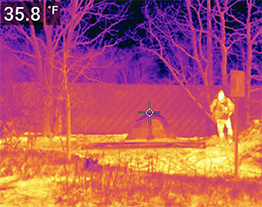
Encampments along roadsides in public rights-of-way (ROWs) create significant safety hazards for the people living in them. Agency staff members working in or near these ROWs also face safety risks. A MnDOT-funded project tested a thermal imaging tool that can help detect people inside tents or other shelters.
The Homeless Encampment Team at MnDOT routinely engages in cleanup and other required maintenance at sites that appear abandoned. By detecting people before entering a camp, staff can interact with residents respectfully while cleaning and maintaining areas safely. If individuals do not respond to verbal announcements, it is difficult to know whether tents or other temporary shelters are occupied.
Researchers tested the effectiveness of a thermal imaging camera to identify human presence in a tent or other shelter. (Thermal cameras can clearly show heat sources not normally visible to the naked eye.) Two test encampments were constructed to approximate the type of tents and other items typically found at sites. The team also conducted a limited number of observations of a live encampment site near Minneapolis.
The results indicate that the camera can help detect active encampments under certain conditions. For example, at 10 degrees Fahrenheit, some tent shelters in the live encampment appeared warmer than the surroundings, indicating occupancy.
The Homeless Encampment Team has also developed MnDOT policies, a training curriculum and draft Encampment Code of Conduct for field staff members, and a mobile application for sharing real-time information.
Learn more:
- Remote Sensing in Unsheltered Encampments (MnDOT, 2022)